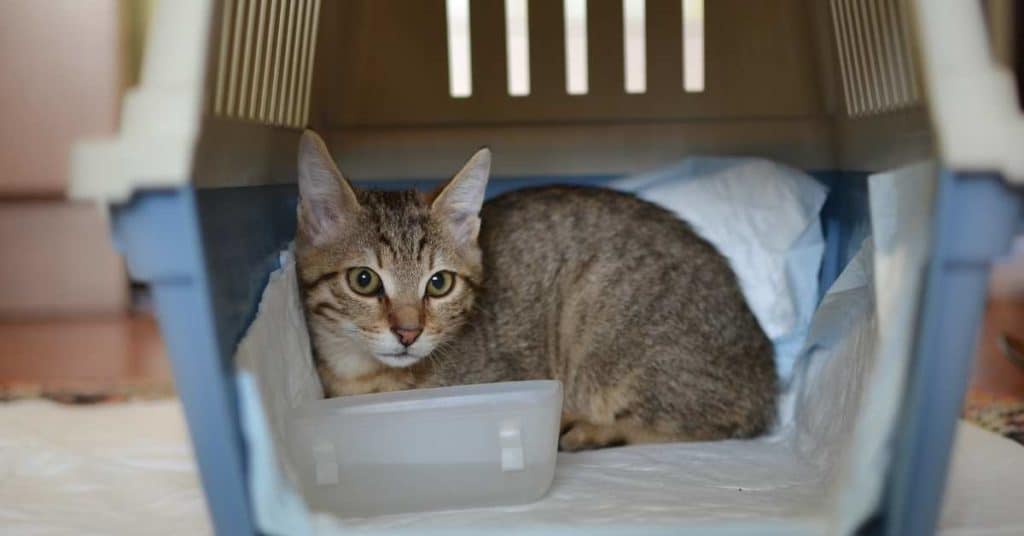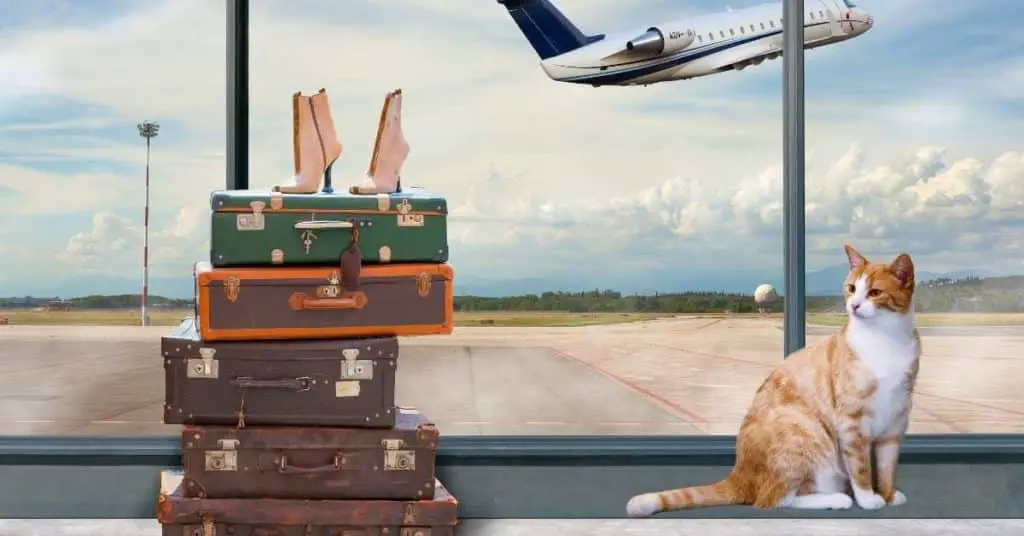How to Take Your Cat on a Plane? (My Experience)
As a cat owner, I know the emotion of wanting to take your cat everywhere with you. Unfortunately, not all places are as pet-friendly as we would like them to be. I personally face this dilemma when I travel by airplane. While you may not be able to bring your cat everywhere, there are some ways that you can make air travel possible for both you and your feline friend.
In this blog post, I’ll be sharing my top tips for taking your cat on a plane. These tips include everything from what type of carrier to use, to how to get your cat acclimated to the airport environment. By the end of this post, you’ll be ready to book your tickets and hit the friendly skies with your feline companion by your side.
My Step by Step Guide for Taking Your Cat on a Plane

Here I’ll go over step by step what you need to do in order to take your cat on a plane. These tips are based on my experience flying with my own cat, and from research I’ve done on the subject.
- Choose the right type of carrier
- Get your cat acclimated to the carrier
- Make a travel plan
- Get to the airport early
- Check in and go through security
- Board the plane
- Take care of your cat during the flight
- Arrive at your destination
- Let your cat out of the carrier
Now let’s get into the details of each of these steps!
1. Choose the Right Type of Carrier
The first step to taking your cat on a plane is choosing the right type of carrier. The carrier you choose should be large enough for your cat to stand up and move around in, but small enough to fit under the seat in front of you. It’s also important to choose a carrier that has good ventilation and is made from sturdy material. I usually opt for a hard-sided carrier because it feels more secure and comfortable for my cat.
2. Get Your Cat Acclimated to the Carrier

Once you’ve chosen the right carrier, it’s time to get your cat acclimated to it. This is important because you want your cat to feel as comfortable as possible during the travel process. Start by placing the carrier in a room where your cat spends a lot of time. Leave the door open so that your cat can come and go as they please. After a few days, you can start putting food and toys inside the carrier to encourage your cat to go inside.
3. Make a Travel Plan
The next step is to make a travel plan. This should include everything from what time you need to leave for the airport to where you’re going to stay once you arrive at your destination. When making your travel plan, it’s important to keep your cat’s needs in mind. For example, if your cat is prone to anxiety, you might want to consider booking a direct flight or taking a shorter trip.
4. Get to the Airport Early
Once you have your travel plan sorted out, it’s time to head to the airport. I recommend getting to the airport early so that you have plenty of time to check in and go through security. This will also give you a chance to acclimate your cat to the new environment.
5. Check In and Go Through Security

When you get to the airport, the first thing you need to do is check in and go through security. When going through security, make sure to take your cat out of the carrier so that they can be scanned separately. This process can be a bit stressful for both you and your cat, so try to stay calm and keep your cat close to you.
6. Board the Plane
Once you’ve made it through security, it’s time to board the plane. When boarding, make sure to put your cat in their carrier and stow it under the seat in front of you. If you’re traveling with a larger cat, you may need to book a seat with extra legroom so that they can stretch out.
7. Take Care of Your Cat During the Flight
Once you’re on the plane, it’s important to take care of your cat during the flight. This includes making sure they have enough food and water and that they’re not too hot or cold. You should also try to keep them amused by playing with them or offering them a toy. If your cat starts to get anxious, you can try giving them a calming supplement.
8. Arrive at Your Destination

Eventually, you’ll arrive at your destination. When you do, the first thing you should do is let your cat out of their carrier so that they can stretch their legs. If you’re staying in a hotel, make sure to ask for a room that’s pet-friendly. And if you’re renting a car, be sure to bring along a pet seatbelt or carrier.
9. Let Your Cat Out of the Carrier
After you’ve arrived at your destination and settled in, it’s time to let your cat out of their carrier. This will give them a chance to explore their new surroundings and get used to the new environment. Just be sure to keep an eye on them so that they don’t get lost or into any trouble.
10. Have a Great Trip!
Assuming everything goes according to plan, you and your cat should have a great trip! Just remember to take things slow and be prepared for anything. And if you have any questions or concerns, be sure to ask a professional before heading out on your journey.
How Much Does it Cost to Take a Cat on a Plane?

One of the most common questions I am asked by cat parents is, “How much does it cost to take a cat on a plane?”
The good news is that you can typically transport your cat in the cabin with you for a fee that is much lower than the cost of shipping your cat as cargo.
The bad news is that the process of taking your cat on a plane can be somewhat complicated and stressful—for both of you. Here’s what you need to know about flying with a cat.
The first step is to check with the airline to find out their specific requirements and fees. Most airlines allow cats in the cabin as long as they are in an approved carrier that fits under the seat in front of you.
The carrier must have ventilated sides and a secure latch. Your cat must also be able to stand up and turn around comfortably inside the carrier. You will likely need to provide proof of vaccination against rabies and other diseases at least two weeks prior to travel.
The cost of taking your cat on a plane will vary depending on the airline, but it is typically between $75 and $200 for domestic flights. International flights may be more expensive.
It is important to note that you will also need to pay for your cat’s food and lodging while at the airport and in route to your final destination. For these reasons, it is important to plan ahead when flying with a cat.
Is it Cruel to Take a Cat on a Plane?

Most cats hate riding in cars, so it’s not surprising that many of them don’t do well on planes, either. That said, some cats make excellent travelers and adjust quickly to flying. And, while it might not be the best experience for your cat, it is usually neither cruel nor unsafe to take him or her on a plane.
The cat’s natural instinct is to hide when faced with something new and frightening, so spending time in their carrier prior to the flight will help them feel more comfortable and less stressed.
Getting used to the carrier at home will also make it easier to get your cat in and out of the airport and onto the plane. Make sure that the carrier is large enough for your cat to stand up and turn around in and line it with a soft towel or blankie.
A Feliway diffuser can also help reduce stress levels (ask your veterinarian for more information). Put the carrier in a quiet room a few days before the trip and let your cat explore it at his or her own pace. Offer treats or meals inside the carrier so that your cat associates good things with being inside it.
If possible, choose a direct flight and avoid layovers since this will minimize your cat’s time in the airport and on the plane. When making reservations, ask if there are any restrictions on bringing live animals onboard and if there are any limitations on where you can sit (some airlines have animal-friendly sections).
Request a seat near the aisle so that you’ll have easy access to your cat during the flight. Finally, pack everything your cat will need for the trip, including food, water, bowls, litter box, scoop, litter, toys, medications (if necessary), and copies of his or her vaccination records.
How do Cats Go to the Bathroom on a Plane?

The first thing to understand is that cats have a very refined sense of smell. This means that they are also highly sensitive to changes in their environment, including things like the motion of a plane.
For many cats, these changes can trigger their natural instinct to urinate or defecate outside of the litter box. While this may be inconvenient for you, it is actually a survival mechanism for your cat.
In the wild, eliminating in an area that is unfamiliar helps to mark their territory and warn off predators or other animals that might threaten them.
There are a few things you can do to help your cat feel more comfortable on a plane and reduce the likelihood of an accident.
First, make sure to choose a litter box that is the right size for your cat. It should be large enough for them to turn around in and deep enough that they can cover their waste.
Second, pack some of your cat’s favorite toys or treats to help them feel more comfortable in their new surroundings.
Finally, consider using a pheromone diffuser in the cabin to help reduce your cat’s stress levels. By following these simple tips, you can help make sure that your cat has a safe and pleasant journey
How to Keep Cat from Meowing on Plane?

If you’re traveling by plane with your cat, you may be wondering how to keep him from meowing the whole way. Cats vocalize for many reasons, including to express fear, pain, hunger, and boredom.
Some cats also seem to meow more when they’re away from their usual environment. There are a few things you can do to help reduce your cat’s stress while traveling and hopefully minimize the amount of meowing he does on the plane.
First, try to acclimate your cat to his carrier well in advance of the trip. Leave it out in a room where he spends a lot of time so that he can get used to it being there.
Put some toys and a soft towel inside so that he associates good things with the carrier. When it’s time to go, put the carrier in a quiet place where he can’t see or hear all the commotion at the airport. This will help him stay calm during the trip.
If your cat is prone to motion sickness, talk to your veterinarian about medication beforehand. Boarding him at an animal hospital or kennel that has experience caring for cats with this condition can also be helpful.
Once on the plane, try not to make too much of a fuss over your cat. He may be scared and meowing more for attention than anything else. If he’s in a window seat, close the shade so he doesn’t have anything else to stare at besides you.
Provide water and food if possible but don’t force him to eat or drink if he isn’t interested. Playing soft music or putting on a video specifically made for cats can also help calm him down during the flight.
Flying with a Cat for the First Time?

It’s not unusual for cats to travel by air. In fact, many cats live out their lives without ever setting paw on an airplane. But some cats do need to fly, whether it’s because their guardians are moving to a new home or they’re going to visit the vet for a procedure that can’t be performed in their local area.
The good news is that flying with a cat can be much less stressful than you might think, as long as you take the time to prepare your cat (and yourself) in advance.
Before you book your flight, talk to your veterinarian about your cat’s health and whether she has any underlying medical conditions that could make flying a risk.
If your cat is healthy and you’ve decided to proceed, make sure she is up-to-date on all of her vaccinations and that she has a current health certificate from your vet.
When it comes time to pack your cat’s carrier, line the bottom with absorbent material in case of accidents and include a favorite toy or piece of clothing with your scent on it to help your cat feel more comfortable.
On the day of travel, keep your cat calm by avoiding anything that might upset her, such as feeding her a large meal before the flight or letting her drink too much water so she’ll need to use the litter box right before takeoff.
With a little planning and preparation, flying with your cat can be a smooth and stress-free experience for both of you.
FAQ’s on Taking Your Cat on a Plane

Does Flying Hurt Cats Ears?
Anytime you take your cat on an airplane (or even just to the veterinarian for a car ride), you might notice that she seems to be in pain. Her ears might be flattened against her head, she might be drooling, and she may keep meowing pitifully.
You might even see blood running from her ears. It’s all very upsetting, but rest assured that unless there is an underlying condition present, your cat’s ears are not actually bleeding.
Just like people, cats’ eardrums are sensitive to changes in pressure. When the pressure changes too quickly, the eardrum can rupture, causing blood and other fluids to leak out.
This is called barotrauma and it is the most likely reason why your cat’s ears seem to bleed when you fly with her. If your cat only has this problem when flying, and her ears look normal at other times, there is no need for alarm.
However, if she seems to be in pain or her ears appear abnormal at other times, make an appointment with your veterinarian. She may have an infection or some other problem that needs to be treated.
Is it Free to Fly with a Cat?
You may have heard that some airlines allow cats to travel in the cabin for free. Unfortunately, that’s not true. All airlines charge a fee when you fly with your cat, and the cost can range from $50 to over $200 depending on the airline and the length of the flight.
What’s more, very few airlines allow cats to fly in the cabin at all. Most require that cats travel as cargo, which can be a stressful and dangerous experience for your pet.
If you’re planning to fly with your cat, be sure to check with the airline well in advance to find out their policies and fees. And, whenever possible, choose an airline that allows you to keep your cat with you in the cabin. It may cost a bit more, but it will be worth it for your peace of mind (and your cat’s safety).
Which Airline is Most Pet Friendly?
Jennifer Coates, DVM, provides an overview of the policies of the most pet-friendly airlines. She includes tips for preparing your animal for travel as well as what to expect during the flight.
The policies of different airlines vary considerably when it comes to transporting pets. The three most pet-friendly airlines, based on my findings, are Alaska Airlines, American Airlines, and Delta Air Lines.
But even these airlines have different rules and regulations regarding which animals they will and won’t transport and where those animals will be allowed to travel within the cabin or cargo hold. Consequently, it is always best to check with the airline you plan to fly before making any travel plans for your pet.
Can I Give my Cat Benadryl Before Flying?
It’s always best to check with your veterinarian before giving your cat any medication, even over-the-counter drugs like Benadryl. In general, though, it is safe to give your cat a small dose of Benadryl before flying to help ease her anxiety.
The standard dose for cats is 1 mg per pound of body weight, given orally every 8 to 12 hours. So, for a 10-pound cat, you would give her 10 mg of Benadryl (one tablet or 5 mL of liquid).
It’s important to note that Benadryl can make your cat drowsy, so be sure not to give her too much. And, of course, never give your cat any medication without first talking to your vet.
My Final Thoughts
Flying with your cat can be a stressful experience, but it doesn’t have to be. With a little planning and preparation, you can make it a smooth and safe trip for both you and your furry friend.
Do your research ahead of time to choose the airline that best fits your needs, and be sure to pack everything you’ll need to keep your cat comfortable during the flight. Most importantly, relax and enjoy the journey!






